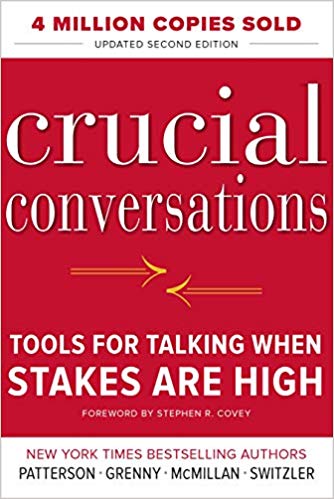

This article is an excerpt from the Shortform summary of "Crucial Conversations" by Kerry Patterson. Shortform has the world's best summaries of books you should be reading.
Like this article? Sign up for a free trial here .
What are the four methods of decision making? How do you know what decision-making technique to use, and when?
The four methods of decision making outlined in Crucial Conversations can help you choose a decision-making technique based on the situation. You’ll also learn how to choose the right decision-making tools and how to apply them.
Four Methods of Decision Making
There are four common methods of decision making. They are: command, consult, vote, and consensus. They reflect increasing degrees of involvement. Increased involvement brings greater commitment but decreased efficiency. The method you use depends on the circumstances.
Command
With command decisions, it’s not your job to decide what to do, only how to make it work. Decisions are made without others’ involvement.
Use this method when:
- Outside forces dictate what happens. For instance, agencies mandate safety standards, or other governing bodies or “higher ups” issue demands. Bosses often pass on the demands of others, rather than having independent authority.
- It makes sense for you to delegate the decision — it’s a low-stakes issue in which you don’t need to take part. You trust the person you designate to make the right decision. Your involvement wouldn’t contribute anything additional.
Consult
Decision-makers invite input from others before they decide. They consult with experts, those affected, and anyone whose opinion would be relevant. This can be an efficient way of gaining ideas and support without bogging down the decision-making process. After gathering ideas, decision-makers evaluate the options, make a choice, and then inform the broader population.
Vote
Voting is appropriate where you have a number of good options, and want to decide in the most efficient way. Members of the team realize they may not get their preferred choice, but aren’t going to debate it.
Consensus
You talk until everyone agrees to one decision. This method has both pluses minuses. It can produce unity and good decisions, or it can be a waste of time.
It should be used only with:
- High-stakes and complex issues, or
- Issues where everyone must support the final choice.
Each one of thee methods of decision making has its place, and should be used for the right reasons. Be sure to carefully consider which decision-making method is the right one for you and your situation.
Methods of Decision Making: Choosing the Right One
In deciding which decision-making method to use, consider four questions;
- Who has a stake? Who wants to participate and who will be affected.
- Who has the knowledge? Identify those with information or expertise you might need.
- Who needs to be on board? What cooperation will you need from authorities and influencers to implement the decision? If you surprise them instead of involving them, they may become opponents.
- How many people need to be involved? Involve the fewest people necessary to make a sound decision, and get commitment.
To avoid these two problems, you need to decide how you’ll decide.
Dialogue isn’t decision-making. It’s a process for gathering all relevant information, which involves everyone. But the fact that someone has shared their input doesn’t mean they’ll get to participate in all decisions.
To prevent misunderstanding, it’s important to separate talking from decision-making: Make clear how decisions will be made, who will make them, and why. This will help you choose the right one of the methods of decision making.
Here are the typical starting points.
Situation 1: When the line of authority is clear
When you’re in a position of authority you decide which of the methods of decision making you’ll use.
For example, managers and parents decide how to decide; it’s part of their responsibility as leaders. Vice presidents don’t ask hourly employees to decide pricing changes or product lines. Parents don’t ask kids to set their own curfew or make household decisions.
Leaders can turn decision making over to direct reports when warranted, but the person in authority still decides which methods of decision making to use. Deciding what decisions to turn over and when is part of their stewardship. This is a well-known decision-making method.
Situation 2: When there’s no established line of authority
Another method of decision making is when there’s no clear line. Then, deciding how to decide can be quite difficult.
For example, if a teacher wants to hold your child back a year but you object, who decides? Who makes the decision should be discussed in the group. If you don’t talk and opinions differ, you’ll end up in a dispute. When authority is unclear, decide together how you’re going to decide.
Include the follow-up method in the assignment. For example, you can tell your kids: “Text me when you’ve finished your homework. Then you can play with friends.” Use milestones: For example, “Let me know when you’ve completed your research, then we can meet and plan the next step.” But make sure milestones are linked to firm deadlines: “You have until the end of the month for the overall project.”
Make Assignments
Once you’ve made your decisions, it’s time for action. To avoid confusion or dropped balls, make assignments. These decision-making techniques can help you follow through on decisions.
Assignments have four elements:
- Identify the tasks: What are the deliverables? Use contrasting (describe what you don’t want and do want), and give specific (not abstract) examples. If expectations aren’t clear, you’ll be unhappy with the results. For example, when you’re planning to remodel a room, if you’re not clear with contractors about what you want up front, there’s a good chance you’ll waste money and end up with something you didn’t want.
- Identify who’s responsible: Assign each task to an individual (this especially applies at home, with household chores, etc.). If you assign a task to more than one person, put one of them in charge. If you don’t attach a name to an assignment, it’s likely nothing will be done.
- Set deadlines: Assignments need specific deadlines. Without a firm deadline, an assignment may get pushed to the back burner as other priorities come up. A deadline of “whenever” will produce more guilt than action.
- Decide how you’ll follow up: Determine how often you’ll follow up, and by what method. Holding people accountable motivates them, and you’ll also create a culture where people keep their promises.
What other decision-making method could have been used? How might it have affected the decision?
The four methods of decision making are all different. As you hone your decision-making techniques, you’ll be able to choose from different decision-making methods and adapt to the situation and conversation.

———End of Preview———
Like what you just read? Read the rest of the world's best summary of Kerry Patterson's "Crucial Conversations" at Shortform .
Here's what you'll find in our full Crucial Conversations summary :
- How to approach an argument without getting mad
- The mistakes most people make when trying to listen to someone else
- How to come up with win-win solutions that make everyone happy






